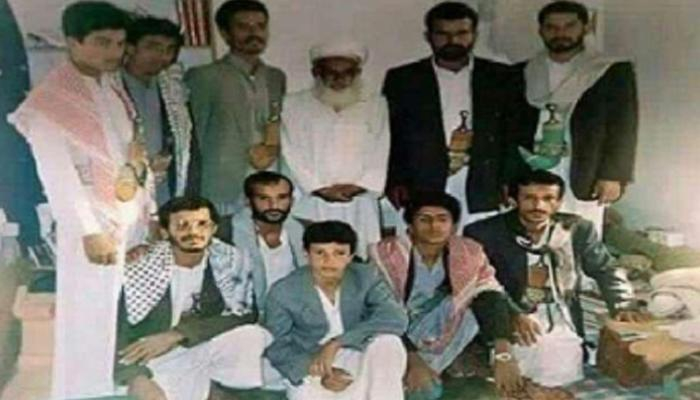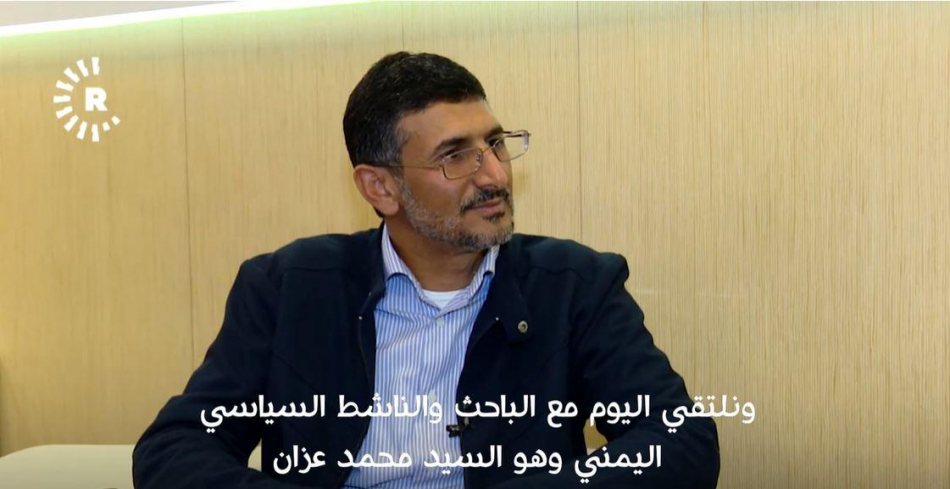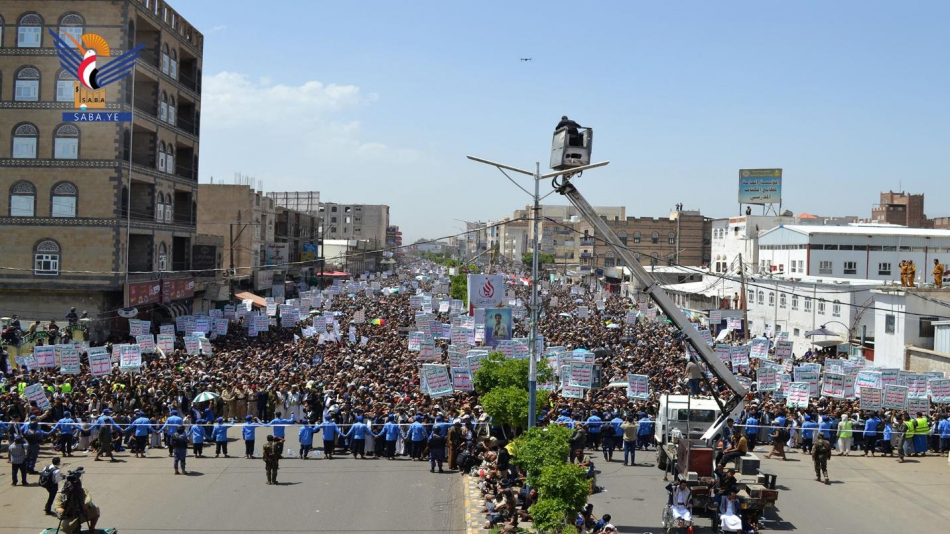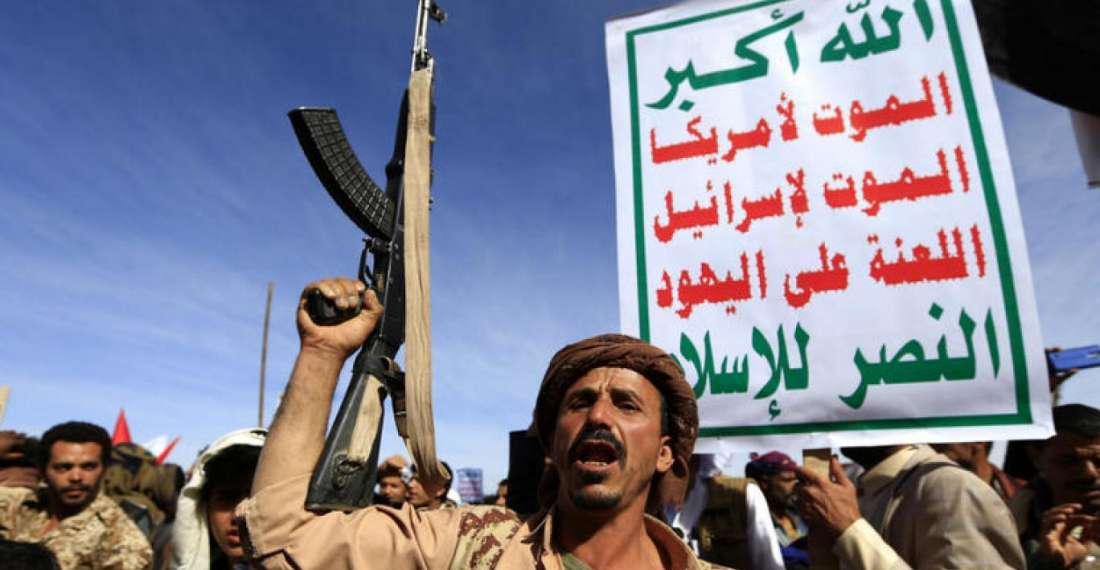One of the several, often overlooked, challenges facing Yemen is the supremacist and divisive ideological basis of the Houthi movement. The movement’s ideology has rebellion and violence at its core, a recipe that can perpetuate crises within a society. In this analysis for commonspace.eu, Noman Ahmed and Mahmoud Shamsan shed light on the ideological fault lines that fuel the current conflict in Yemen, highlighting the nature of this ideology, which suggests that Ahl al-Bayt — descendants from the family of the Islamic Prophet — are, by divine decree, considered to be more deserving of the right to greater political and religious rule than other socio-political components. The analysis then looks into the background of the Houthis and argues that the ideology is a catalyst for conflict rather than peaceful political competition, and that so long as the Houthi political goal of Hashemite1 dominance remains unrealised, Houthi desire for conflict will not recede.
A fair discussion about the Houthis requires a glimpse into the history of Islam. After the death of the Islamic prophet, Muhammed, there was a dispute over who the next spiritual and political leader— known formally as the Caliph and overseeing the executive institution known as the Caliphate — should be. Abu Bakr Al Siddiq, followed by Umar ibn Al-Khattab, Uthman ibn Affan, and Ali ibn Abi Taleb (Imam Ali) were eventually chosen. Imam Ali, who was the prophet’s cousin and son-in-law, was murdered for political motives surrounding the issue of succession. Imam Ali’s son, Al-Hassan, later decided — and by other accounts, was forced — to give up power to Mu’awiya ibn Abi Sufyan to end the rift. Mu’awiya was a Hashemite who, although not coming from the lineage of Muhammed, went on to establish the Umayyad dynasty. However, Al-Hussain, Al-Hassan’s brother, refused to accept and headed to Iraq to protest against the second Umayyad Caliph Yazid ibn Mu’awiya. Al-Hussain was however killed on his way to Iraq, triggering the establishment of Shia Islam. One of the main differences between Sunni and Shia Islam is how they each determine who had the right to rule and what path of lineage ought to be followed. Sunni Islam believes that transferring the rule of the caliphate to the Umayyads following the first four Caliphs was correct. Shia Islam argues otherwise and believes that Al-Hussain was the righteous leader of Muslims after Imam Ali, with other Shia sects arguing that Imam Ali should have been the first successor from the onset of the post-Muhammed period. Sunni Islam argues that a leader should be elected based on Shura (public consultation) and not necessarily be from the direct or indirect descendants of Muhammed2. Shia Islam, on the other hand, argues that Al-Hussain was a rebel against what they described as the “injustice of the Umayyads”. Leadership in Shia Islam is therefore passed down by direct lineage from Al-Hassan and Al-Hussain, but not necessarily based on merit, knowledge and qualifications3.
Followers of Al-Hussain, the Shiites, were later divided into several groups with two main groups coming to the forefront (Al-Batol, 2007). The first and the largest group became known as the Twelvers, who claimed that the Imamate4 should be hereditary from the dynasty of Al-Hussain. For them, Ali ibn Al-Hussain, followed by his eldest son Muhammed ibn Ali Al-Baqir, going down the lineage to the twelfth Imam, Hujjat Allah ibn al-Hassan, are the Imams of the Muslim community who should have ruled after the Prophet passed away. The twelve Imams starting from Imam Ali thus became the core Imams of this group. The second main group considers that power is deserved by virtue (with the exact conditions that determine virtue changing across time and places). They neither called for one specific descendant to be Imam, nor asked for the rule of heredity to be applied. Instead, they stated that the Imam should generally be elected from either Al-Hassan’s or Al-Hussain’s ancestry. In addition, the second group does not deny the first three Caliphs before Imam Ali as the righteous leaders, unlike the Twelvers who stated that Imam Ali should have been the first ruler after Muhammed. This second group came to be known as Zaydis, based on Imam Zayd (great-grandson of Imam Ali) who was born in Medina in the 7th century. Imam Zayd was the brother of Muhammed ibn Ali Al-Baqir (the fifth Imam according to the Twelvers).
Although the two groups had theological and practical differences, they agreed that the Imam should be a descendant of the Prophet and not just any privileged Hashemite (Maqbool, n.d). Both Zaydis and Twelvers went through ebbs and flows establishing rule at various times over changing geographical spaces. The school under examination in this paper is the Zaydi school which, since its onset, sought to establish a state in Yemen and later succeeded on multiple occasions. The Zaydis chose Yemen due to its earlier role in supporting Islam and protecting the oppressed (Sulz, 2018). Yemen eventually became a place where rebel movements against the Islamic dynasties mobilised because it was far from the political centres of Islamic rule and boasted a strategic topography (Al-Taie, 2020).
The early Zaydis, who had at that point still struggled to establish a state, chose Yemen to escape persecution from Umayyads. Nevertheless, Muhammed ibn Ibrahim Al-Rassi led the first attempt to establish a Zaydi state in Egypt by sending his brother, Al-Qasem ibn Ibrahim Al-Rassi, there. They both failed to achieve anything in Egypt due to the perception of Zaydis as rebels (Ibid). Al-Qasem ibn Ibrahim Al-Rassi then started visiting Yemen frequently, but the local population rejected his ideas. Al-Qasem Al-Rassi then started to build crucial connections with some tribal heads coming from Yemen to Mecca for pilgrimage. Those Yemeni tribes later helped Al-Rassi’s grandson, Yahya Al-Rassi, in establishing the first Zaydi state (Sulz, 2018, p. 2). The widely circulated narrative states that Al-Rassi was once invited to Yemen to solve a tribal dispute and, using his wisdom, he was able to win the hearts and minds of the tribe members, which in turn helped him establish political presence. The early Zaydis (Rassid dynasty) knew that by gaining the support of tribal heads for their cause, they could ensure support from the entire local tribes thus securing their newfound political influence (Alziady, 2021, p. 803). Although many tribes initially resisted the Zaydi presence, they eventually decided to side with the Zaydis as their interests coincided with rising frustration towards the Sunni dynasties. Political pragmatism thus helped Yahya Al-Rassi in establishing the Zaydi state by the end of the 9th century. Various Zaydi states, with various degrees of extremism, subsequently emerged and disappeared, with the last one, The Mutawakkilite Kingdom, ruling from 1918 to 1962. Those Zaydi states had various degrees of sovereignty as the state sometimes extended its control over vast geographical areas, while at other times finding itself limited in other areas. Since the 9th century, two major schools of thought of Islam have existed in Yemen, namely the Sunni school (The Shafi branch), and the Shiite Zaydi school. Societies from both sects became part of the cultural identity of Yemen. Sunni Islam and Zaydism do not have major theological differences when it comes to the practices and beliefs of Islam. The main point of difference is the identity and status of the political leader as well as the qualifications of the leader and his background. Those differences, however, did not hinder societies from both sects from coexisting for centuries. Nonetheless, both sects were heavily politicised at various points leading to conflicts based on political competition (Al-Daghshi, 2010).

The latest form of politicisation happening to the Zaydis occurred in the late 20th century as the Houthis revived elements from the then-extinct Jarudi branch of Zaydism. Jarudism was a branch of Zaydism that was closer to the Twelver ideology currently being practised in Iran. The influential leader, Hussein Al Houthi, chose Jarudi Zaydism as he differed in position and approach from the mainstream Zaydis known as the Haduwi5. Having visited Iran multiple times, Al Houthi was poised to radicalise the movement by reviving Jarudi beliefs. This has led to an ongoing discussion about the Iranian role in Yemen and their support of the Houthi movement. The extremist aspect of Jarudi Zaydism originates from their belief that the Al-Hussain lineage has been blessed by divine order to rule and therefore politically superior to other sects. This results in the community believing that they have a right to do whatever it takes, including by violent means, to bring society back to order. The difference between the Haduwi and Jarudi branches of Zaydism is that the former recognises all the first four Caliphs, while the latter denies the first three Caliphs. Jarudi Zaydism also focuses on the notion of the exclusive right of Al-Hussain’s hereditary lineage to exercise sovereignty, and on the unfitness of others to rule even if they were Hashemites6. Jarudism, thus, is closer to Twelver Shia Islam rather than Zaydi Shia Islam. In fact, nowadays, Shiites are known to be those who follow the Twelver branch and not the Zaydi branch. It is important to note that there is a debate here among scholars and historians. Some argue that even Haduwis advocated for a rebellious spirit like Jarudis/Twelvers and often demanded a leader succeeds their father and not be chosen. Others, however, have expressed a more tolerant reflection of Haduwis in that they accepted a leader from outside Ahl al-Bayt, like the Sunnis, but instead the leader would be called a “person-in-charge” rather than an Imam (Shuja al Deen, 2016).

The Houthis had to consolidate their power at the turn of the 21st century. The extremist wing of the movement started pushing for their narratives within the established Zaydi movements7. They did so in many ways that can be further debated and analysed. In fact, the Houthis' rise to power and modes of influence are a subject of wider geopolitical debate that often also involves the role of the neighbouring countries and local power struggles within Yemen. In their quest for consolidation, the Houthis were careful not to appear like The Mutawakkilite Kingdom, the latest Zaydi dynasty who had frequently mistreated the local population based on account of their “superiority”. To win the hearts and minds of Yemenis and not to draw synergies with the former Zaydi dynasties8, the Houthis changed some terms such as Imamate to Al-Wilayah. The Houthis used an extreme version of Zaydism that characterised non-Hashemites as inferiors and those opposing them as infidels based on a belief in divine order. As Badr al-din Al Houthi—father of Hussein Al Houthi and of its current head, Abdulmalik Al Houthi —says:
“Wilaya, the Power, is for Ali after prophet Muhammed and to Ali's good lineage from Al-Hasan and Al-Hussein [spelled above “Al-Hassan” and “Al-Hussain” respectively] and their good offsprings and Willaya for those whom Allah made the power to in his book and his prophet's sayings, whether the people accept it or not. This is a matter decided from Allah not by Shoura” (Al-Batol, 2007).
The Yemeni thinker and scholar Mohammed Mahmoud Al-Zubairi captured this extreme narrative by recalling the days of the former Imamate, as Yemenis were struck with the reality that:
“one person believes that his authority comes from the heavens, that God has chosen him to rule over the people, that God instructs him when to work and when not to work...and that people turn into criminals and thieves if the Imam is not satisfied with them… and that the Imam can kill them or imprison which in case, the order is heavenly and not judiciary” (Al-Zubairi, 1983).
The evolution of the Houthi movement
The term ‘Houthi movement’ became popular among Yemenis in the first decade of the 21st century and once again during the 2011 protests. In 2014, the Houthis, also known as Ansar Allah, toppled the legitimate government and took over the capital Sanaa. Like most surnames in Yemen that refer to places, Houthi refers to Huth, a village in Amran governorate situated between Saadah and Sanaa (Serjeant & Wilson, 1989). The core family who led the movement, including its current head, Abdulmalik Al-Houthi, descends from a Hashemite family and claims to be descendants of Al-Hussain. The structural origins of the Houthi movement date back to 1992 when Mohammed Azzan, an Islamic Zaydi researcher, co-founded what was known as “The Believing Youth” (BY) movement9. The BY sought to revive Zaydi beliefs and ideals in society through social and cultural means, regardless of tribal or ancestral origins. This desire for revival and the eventual success of the revivalist movement is driven by many factors.
Firstly, the Yemeni state was facilitating the rise of various, often aggressive trends unfamiliar to Yemeni society such as Salafism, Wahhabism and Secularism10. This would often occur in areas such as Dammaj which today are under the Zaydi sphere of influence. Since the 1990s, the Zaydis felt their identity and roots were being eroded by such “foreign” trends as they challenged their long-established social and religious jurisprudence. Eventually, these ideas were perceived as a threat, thereby paving the way for movements such as the BY to gain traction. Secondly, there was sedition fuelled by some influential Yemenis who made objective arguments against Zaydi beliefs throughout the 1990s and 2000s. Such sedition gradually but inevitably made the BY appeal to young Zaydis. Thirdly, another reason for Zaydi communities’ return to their roots following the establishment of the BY occurred in the period following the 1962 revolution, during which time Zaydi strongholds were neglected and their societies felt excluded (Sulz, 2018).
Conversely, however, the BY movement during the 1990s also received a boost from the regime. This occurred for several reasons. First of all, the BY was perceived as a more moderate movement that did not necessarily encourage the concept of leaving the guardianship (i.e., rebellion), as does Jarudi Zaydism11. A second reason for the regime’s support for the BY concerned the demographic situation at the time. The regime initially wanted a counterweight against a challenge from Salafist and Islamist groups who were gaining unprecedented traction. Former president Ali Abdullah Saleh also used the BY movement as a pressure card against the Saudis along the border (Alziady, 2021), and the BY were in this regard eventually successful. On the other hand, after decades of the regime attempting to foster a republican, secular identity at the expense of the Zaydi identity, the BY was successful in graduating generations from summer camps that prioritised their Zaydi identity over the republican identity of the state. Furthermore, the BY was not the only Zaydi movement in Yemen in the 1990s. A group of Zaydi elites formed the Zaydi revivalist Al-Haq party, of which Hussein Al Houthi was a member. Towards the late 1990s, a division occurred in the BY which was different from both the original position of the BY and the Al-Haq party. This offshoot was initiated and maintained by the Houthi family, namely Hussein Al Houthi, when he joined the BY in 1999 (Nagi, 2019).
The offshoot came at a time of wider frustrations in the region, including the rise of extremist political Islam and the increased US involvement in the Middle East. Hussein Al Houthi was vastly different from the BY co-founder Mohammed Azzan and the position of the BY and was deeply frustrated by the changing geopolitical situation at the turn of the century. Hussein Al Houthi held on to the idea of rebellion, and in his efforts to change the movement he often brought elements from Twelver Shia Islam rather than Zaydism. Azzan recalls this internal dispute amongst the BY after Hussein Al Houthi joined. He states that the dispute was between two lines: one that supported openness to others and dialogue; and another line that tended to instrumentalise old intellectual topics and focus more on traditional thought. Hussein Al Houthi argued that the BY needed to expand, and he eventually led the expansion efforts through violence (Al-Daghshi, 2013) (Shuja al Deen, 2016). Azzan noted that it was clear to those dealing with Hussein Al Houthi after 2000 that his ideals were not traditional Zaydi ideas, but rather borrowed from Twelver Shiism. His teachings were more rebellious as he criticised other doctrines such as the Sunni sects. Hussein also waged a war against the established Sunni principles of Islamic jurisprudence and the rational philosophies upon which Islam was founded 1400 years ago (Al-Daghshi, 2013) (Sulz, 2018, p.8).

This revolutionary spirit led Hussein to prominence and his conflict with the BY’s administration encouraged him to take a different path. Hussein capitalised on the Zaydi sentiment of the loss of the Imamate system and the grievances caused by sedition, arguing that external ideologies such as Salafism and Wahhabism threatened the Zaydi identity. Today, however, historians are divided over what followed. Some say that Hussein Al Houthi first considered a military campaign against the state and sought to create a militia similar to Hezbollah; others say the military branch of the movement was established after Hussein Al Houthi was killed in September 2004. Nonetheless, Hussein was the ideological powerhouse behind the transformation of the movement. The conflict in June 2004 - the first armed conflict involving the Houthis - was a turning point after which their rebellious spirit and recruitment efforts widely increased. The alliance of the Yemeni regime with the United States in the aftermath of 11 September attacks gave the Houthis a stronger motive to fight the government forces. After six rounds of fighting that ended in 2010, the movement had established itself with massive influence over Saadah12.

The Yemeni civil war is a result of a supremacist and divisive ideology
The supremacist and divisive practices of the Houthis served as a catalyst for political conflict that undermined stability and contributed to their rebellion in 2014. Rebellion was an inevitable goal for the Houthis once they had acquired the necessary means during and after the chaotic events of 2011-2012. Alziady (2021) explains that:
“The Houthi family claims its Hashemite origin and being descendants of Prophet Muhammed which in result according to their ideology gives them the right to declare their Imamate, after more than 50 years of its end. Under the leadership of Hussein Al-Houthi, the movement transformed from being a religious-cultural movement to a military entity seeking to restore the glory of the Imamate.” (p.805).
Stipulating that those who do not believe in the divine right for Ahl al-Bayt to rule are traitors, Jarudi Zaydism spread through Yemen via the support of Houthis and the movement found itself in continuous war with its Islamist, secularist, leftist, or Southern secessionist opponents. This is because Houthi ideology fuels conflict on an unprecedented scale by dividing Yemeni society into those who are fit and those who are not based on a belief in divine rule. In the aftermath of the 2014 coup, Houthi authorities replaced government and military officials with Hashemite Zaydi officials who are appointed for their identity rather than merit (Ghanem, 2019). The war, in the context of the political dispute and the aforementioned societal division, inevitably led to social fragmentation. As Ghanem describes it, the war “exacerbated long-standing grievances and created new fractures in Yemen’s social fabric” (Ibid). The conflict is a political struggle for power based on an ideological self-perception of superiority that has its roots in the onset of the Islamic civilisation.
One of the manifestations of the Houthis’ desire for war is religious schools and training camps in which, through training courses on Zaydi faith and Houthi values of supremacy and rebellion, they encourage the youth to join the fight (Alziady, 2021). The essence of their education is building and sustaining the preference of Hashemites over other ranks of Yemeni society. This is done not only via these schools, but through media and the public sphere too. The ramification of this policy is that the Houthis raise generations that believe in and are ready to sacrifice themselves for the Houthi cause. The Houthi narrative was strengthened by the Saudi intervention in 2015 as the Houthis then framed their actions as a defence against foreign aggression. The patriotic narrative also gained traction among young Yemenis, including many non-Zaydis and non-Hashemites, as fighting for one’s country was deemed patriotic. Another example of how Houthi ideology fuels war is their response to the inheritance issue raised in 2003 and afterwards. From 2003, a fear arose among the Houthis that Ahmed Ali Saleh would inherit his father’s position as leader. The Houthis, who were by then an established movement, were furious at the idea that power would be transferred to a new non-Hashemite leader, contrary to their own beliefs of Hashemite dominance and right to rule. The Houthi movement then encouraged resistance leading to the first Houthi war of 2004.
The Houthis have stated their preference for Hashemite dominance multiple times. So long as that vision is not realised, the Houthis’ desire for war is unlikely to recede. The Houthis, and before them the extreme Zaydi political movements throughout the centuries that tried to achieve this vision, framed the 2004 war as divine and excluded other Yemenis who refused this divine rule, calling them traitors. Human rights groups have pointed out multiple atrocities such as violent threats, extrajudicial executions, and other criminal activities including against those from their own group who disagree with the leadership. Throughout history, various incarnations of a Zaydi revival movement attempting political life failed largely because an extreme wing within managed to control the movement from behind the scenes. In our modern times, this extreme tendency – The Houthis – could not have agreed to a republican system as it sees society as legitimate only under a ‘Wilaya’ system.
A way forward?
Yemeni society is suffering from atrocities committed by various local and international actors. This article attempted to explain the local context of the conflict i.e. the conflict amongst the Yemenis themselves over how society ought to be governed. The damage from this war affects the Yemeni people primarily. The international community is concerned about geopolitical ramifications and regional security but addressing these security concerns is a relief only for the international community and not for the Yemenis themselves who continue to suffer from closed roads, security challenges and poor provision of basic needs. A comprehensive vision for peace should not only address the concerns of the coalition but also create a common ground for a proper inter-Yemeni dialogue devoid of foreign influences or personal motivations. A vision for peace should also include a proper developmental and humanitarian approach, and not only a political settlement. It should also give attention to the largest and the most affected demographic, the youth. Such a dialogue needs to have the goal of solving the crisis of legitimacy by identifying how Yemeni society should be governed; the chosen method of governance must not be based on divine belief in superiority.
A look towards the future of peace in Yemen should consider the shape and nature of the government as well. Governing practices should be based on free, fair, transparent and legitimate principles rather than supremacist and divisive narratives. Going forward, the centralisation of power is unlikely to be a tangible model of governance (Ghanem, 2019). The federal model of governance needs to be reconsidered to avoid giving any province an unfair comparative strategic advantage over other provinces. The current and future governments should also promote good citizenship that encourages adherence to rights and responsibilities while guaranteeing basic political freedoms such as freedom of expression, assembly, and choice. Civil appointments must be based on merit and not a sect, tribe, or any other affiliation. The state should also adopt a model of good governance that prioritises good management of state institutions and departments. The members of these institutions should also foster loyalty to their duty and not to a certain tribe or figure. These aspirations are not new to Yemenis, yet achieving them requires urgent, bold and thoughtful action.






